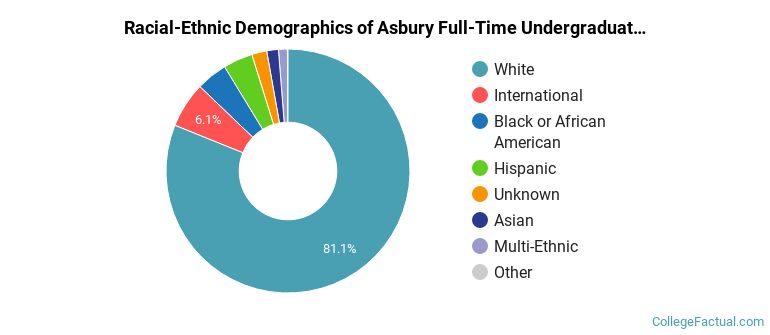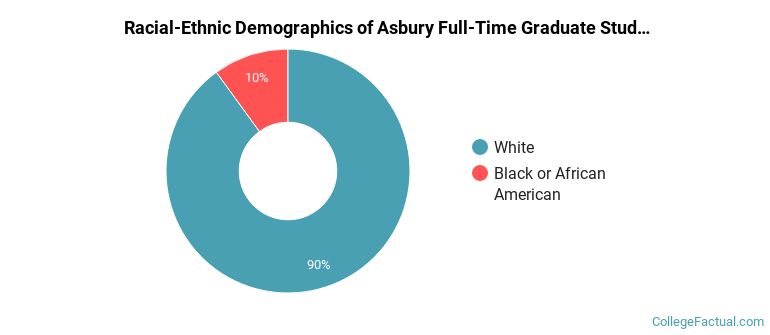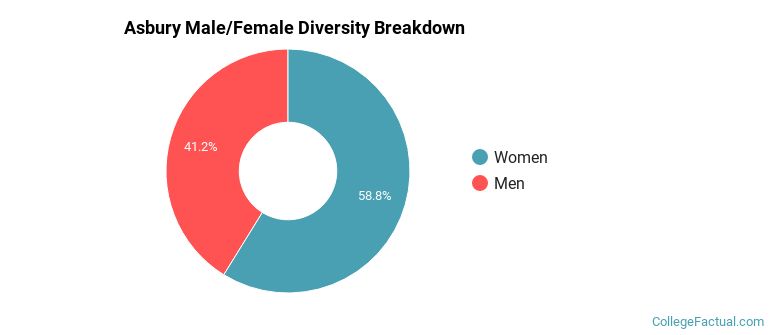 by our College Data Analytics Team
by our College Data Analytics TeamAsbury total enrollment is approximately 1,741 students. 1,240 are undergraduates and 32 are graduate students.
Male/Female Breakdown of Undergraduates
The full-time Asbury undergraduate population is made up of 59% women, and 41% men.

For the gender breakdown for all students, go here.
Asbury Racial/Ethnic Breakdown of Undergraduates

| Race/Ethnicity | Number |
|---|---|
| White | 1,007 |
| International | 63 |
| Hispanic | 56 |
| Black or African American | 55 |
| Asian | 20 |
| Unknown | 19 |
| Multi-Ethnic | 16 |
| Native Hawaiian or Pacific Islander | 0 |
See racial/ethnic breakdown for all students.
Male/Female Breakdown of Graduate Students
About 44% of full-time grad students are women, and 56% men.

For the gender breakdown for all students, go here.
Asbury Racial-Ethnic Breakdown of Graduate Students

| Race/Ethnicity | Number |
|---|---|
| White | 27 |
| Asian | 1 |
| Black or African American | 1 |
| Hispanic | 1 |
| International | 1 |
| Unknown | 1 |
| Native Hawaiian or Pacific Islander | 0 |
| Multi-Ethnic | 0 |
See racial/ethnic breakdown for all students.

| Race/Ethnicity | Number |
|---|---|
| White | 1,372 |
| Hispanic | 109 |
| Black or African American | 89 |
| International | 79 |
| Unknown | 41 |
| Asian | 28 |
| Multi-Ethnic | 19 |
| Native Hawaiian or Pacific Islander | 0 |

There are approximately 1,041 female students and 700 male students at Asbury.
Asbury ranks 485 out of 2,183 when it comes to geographic diversity.
46.37% of Asbury students come from out of state, and 5.56% come from out of the country.

The undergraduate student body is split among 29 states (may include Washington D.C.). Click on the map for more detail.

| State | Amount |
|---|---|
| Kentucky | 155 |
| Ohio | 28 |
| Indiana | 19 |
| Georgia | 11 |
| Michigan | 8 |
Students from 35 countries are represented at this school, with the majority of the international students coming from South Korea, Canada, and Malaysia.
Learn more about international students at Asbury.
A traditional college student is defined as being between the ages of 18-21. At Asbury, 51.66% of students fall into that category, compared to the national average of 60%.

| Student Age Group | Amount |
|---|---|
| 20-21 | 522 |
| 18-19 | 506 |
| 35 and over | 307 |
| 22-24 | 252 |
| 25-29 | 178 |
| 30-34 | 141 |
| Under 18 | 0 |
Footnotes
*The racial-ethnic minorities count is calculated by taking the total number of students and subtracting white students, international students, and students whose race/ethnicity was unknown. This number is then divided by the total number of students at the school to obtain the racial-ethnic minorities percentage.
References
Department of Homeland Security Citizenship and Immigration Services
Read College Factual's Diversity Ranking Methodology.